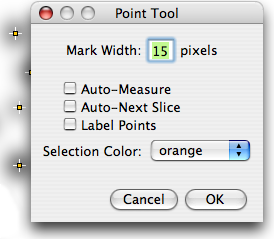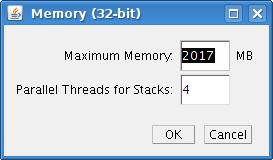−Table of Contents
Options
A number of options to change various ImageJ user preference settings.
Use commands in this submenu to change various ImageJ user preference settings.
Line Width...
Displays a dialog box that allows the width of lines (in pixels) generated by the Draw command to be changed.
Input/Output
JPEG Quality: Use this dialog to specify the compression level use by the File>Save As>Jpeg command. Requesting a higher degree of compression (a lower value) will produce smaller files, but poorer image quality. Please note that it is not a good idea to use lossy-encoded Jpeg formatted images when doing image processing and analysis. Jpeg compression alters the content of the original image and introduces artifacts.
The Save As JPEG macro creates a command that allows the user to press “j' to set the compression level and save in JPEG format.
GIF Transparent index allows the user to specify the transparent color used for images saved in GIF format (use -1 for “none”).
File Extension for Tables: This option lets you select the default extension (not format) when saving tables. (You may also want to install the Excel Writer plugin).
Use JFileChooser to Open/Save: This options enables versions of File>Open and File>Save As that use the Java JFileChooser instead of the native OS file open and save dialogs. The main advantage of JFileChooser is the ability to open multiple files by shift-clicking to select multiple contiguous files and control-clicking to select more than one individual file. On the other hand, it is slower, uses more memory, and does not behave like the file open and save dialogs used in other applications.
Export Raw in Intel Byte Order: There are different ways of saving the byte order in a sequence. This function allows to export the raw data in the order used by Intel x86 based processors (little-endian). See this Wikipedia article.
Fonts
Opens a small window with three popup menus for specifying the type face, size, style and antialiasing (Smooth checkbox) of the font used by the text tool.
Profile Plot Options
Use this dialog to control how plots generated by Analyze/Plot Profile are displayed.
Width and Height specify the size of the plot in pixels.
If Fixed Y-axis Scale is checked, the y-axis range is fixed and the specified Minimum Y and Maximum Y values are used, otherwise, plots are scaled based on the minimum and maximum gray values.
Check Do Not Save X-Values to have “List“, “Save” and “Copy” in profile plot windows display or save only y-values.
Check Auto-close to have profile plot windows automatically closed when “List”, “Save” or “Copy” are clicked on.
Check Vertical Profile to generate row average plots of rectangular areas instead of the default column average plots.
Check List Values to automatically open the list of values. If Auto-close is also checked, the plot is closed and only the list of values remains open.
Check Interpolate Line Profiles to get profile values interpolated along the line selection.
Check Draw Grid Lines to have gray grid lines in the plot.
Point Tool...
Use this dialog to configure the point selection tool. You can also display this dialog by double-clicking on the point tool icon.
If Mark Width is greater than zero, and Auto-Measure is enabled, a mark of the specified size is drawn when you click with the point tool. If Auto-Measure is not enabled, the mark is drawn when you use the Measure command.If Auto-Measure is enabled, ImageJ records the location of point tool mouse clicks.
If Auto-Next Slice is checked, ImageJ advances to the next stack slice after each measurement is recorded.
If Label Points is checked, a numerical label is added as an overlay to the image. Press SHIFT to keep all the selected points on screen while clicking (i.e. multiple selection).
Colors
This dialog lets you choose (from a list) the color of the foreground, background and selection.
Appearance
A number of options regarding the displaying of images.
Interpolate Zoomed Images: self-explanatory.
Open Images at 100%: self-explanatory.
Black Canvas: This option makes the image canvas space (which is white by default) to be rendered in black. This option is useful when looking at X-ray images, to avoid high contrasting intensities at the image edges.
Use Inverting Lookup Table: the Inverting Lookup Table renders the image inverted grey scale values without changing the pixel values.
Double Buffer Selections: This option reduces flicker when working with complex selections but it also increases memory usage and slows screen updates. It is not needed on Mac OS X, which has built in double buffering.
Menu Font Size: allows selection of the ImageJ font sizes. Use a size of “0” (zero) to use Java's default menu font size. Changing the font size requires a restart of ImageJ.
Conversions
Use this dialog to set options that control how images are converted from one type to another.
Check Scale When Converting to have ImageJ scale from min-max to 0-255 when converting from 16-bits or 32-bits to 8-bits or to scale from min-max to 0-65535 when converting from 32-bits to 16-bits.
If Weighted RGB Conversions is not checked, the formula:
gray = (red + green + blue) / 3
is used to convert RGB images to grayscale.
If this option is checked, the formula
gray = 0.299 * red + 0.587 * green + 0.114 * blue
is used instead. The default weighting factors (0.299,0.587,0.114), which are based on human perception, are the ones used to convert from RGB to YUV, the color encoding system used for analog television. The weighting factors can be modified using the setRGBWeights macro function.
Memory and Threads
Use this dialog to specify the maximum amount of memory available to ImageJ.
Java applications such as ImageJ will only use the memory allocated to them but this dialog allows the user to allocate more than the default 128MB. Note that specifying more than 75% of real RAM could result in virtual RAM being used, which may cause ImageJ to become slow and unstable. Also note that this dialog cannot be used to set the memory allocation if ImageJ is run from the command line (linux) or by double-clicking on ij.jar.
See this FAQ about increasing the memory available to ImageJ.
Click on the status bar and ImageJ will display the amount of memory currently in use and the maximum amount available. In the illustration, 129MB out of the available 1000MB, or 12%, is in use. Clicking on the status bar also runs the Java garbage collector, which will attempt to reclaim unused memory.
The Parallel Threads for Stacks which defaults to the number of available processors was added in v1.38u.
Compiler
Displays a dialog box with options for the Plugins>Compile and Run function.
Target is the java version of the class files creted by Plugins>Compile and Run. When set to a version higher than that of the Java Virtual Machine (JVM) running ImageJ, it will be set to the JVM version.
Activate Generate Debugging Info (javac -g) for including the information needed by Java debuggers in the class file.
Misc
Displays a dialog box containing miscellaneous options.
The Divide by Zero Value specifies the value used when Process>Image Calculator detects a divide by zero while dividing one 32-bit real image by another. The default is infinity. In addition to numeric values, “infinity” (positive or negative infinity), “max” (largest positive value) and “NaN” (Not-a-Number) can be entered as the Divide by Zero Value value.
Check Use Pointer Cursor and ImageJ will use an arrow cursor instead of the default crosshair that is sometimes difficult to see on grayscale images in areas of medium brightness. This option can also be used to work around a bug on Windows where the text cursor is sometimes used in place of the crosshair. Note that ImageJ must be restarted when running v1.33l and earlier.
Check Hide “Process Stack?” Dialog to suppress the dialog that asks “Process all xx slices?” (only the current slice will be processed).
Check Antialiased Tool Icons to use antialiased icons. Requires v1.37c.
Check Require Control Key for Shortcuts if you require to press the CTRL key when calling shortcuts.
Check Debug Mode to enable display of debugging messages in the “Log” window. Close the “Log” window to disable display of debugging messages.



